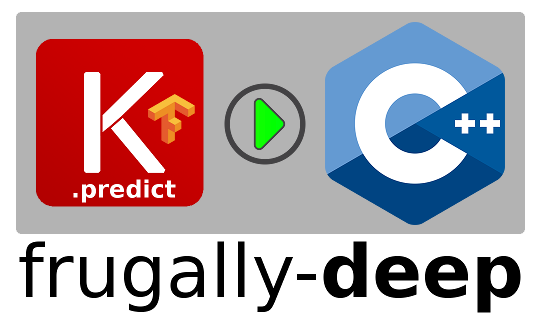Dobiasd / Frugally Deep
Projects that are alternatives of or similar to Frugally Deep
frugally-deep
Use Keras models in C++ with ease
Table of contents
Introduction
Would you like to build/train a model using Keras/Python? And would you like to run the prediction (forward pass) on your model in C++ without linking your application against TensorFlow? Then frugally-deep is exactly for you.
frugally-deep
- is a small header-only library written in modern and pure C++.
- is very easy to integrate and use.
- depends only on FunctionalPlus, Eigen and json - also header-only libraries.
- supports inference (
model.predict) not only for sequential models but also for computational graphs with a more complex topology, created with the functional API. - re-implements a (small) subset of TensorFlow, i.e., the operations needed to support prediction.
- results in a much smaller binary size than linking against TensorFlow.
- works out-of-the-box also when compiled into a 32-bit executable. (Of course, 64 bit is fine too.)
- utterly ignores even the most powerful GPU in your system and uses only one CPU core per prediction. ;-)
- but is quite fast on one CPU core compared to TensorFlow, and you can run multiple predictions in parallel, thus utilizing as many CPUs as you like to improve the overall prediction throughput of your application/pipeline.
Supported layer types
Layer types typically used in image recognition/generation are supported, making many popular model architectures possible (see Performance section).
-
Add,Concatenate,Subtract,Multiply,Average,Maximum -
AveragePooling1D/2D,GlobalAveragePooling1D/2D -
Bidirectional,TimeDistributed,GRU,LSTM,CuDNNGRU,CuDNNLSTM -
Conv1D/2D,SeparableConv2D,DepthwiseConv2D -
Cropping1D/2D,ZeroPadding1D/2D -
BatchNormalization,Dense,Flatten -
Dropout,AlphaDropout,GaussianDropout,GaussianNoise,RandomRotation -
SpatialDropout1D,SpatialDropout2D,SpatialDropout3D -
MaxPooling1D/2D,GlobalMaxPooling1D/2D -
ELU,LeakyReLU,ReLU,SeLU,PReLU -
Sigmoid,Softmax,Softplus,Tanh UpSampling1D/2D-
Reshape,Permute Embedding
Also supported
- multiple inputs and outputs
- nested models
- residual connections
- shared layers
- variable input shapes
- arbitrary complex model architectures / computational graphs
- custom layers (by passing custom factory functions to
load_model)
Currently not supported are the following:
ActivityRegularization,
AveragePooling3D,
Conv2DTranspose,
Conv3D,
ConvLSTM2D,
Cropping3D,
Dot,
GRUCell,
LocallyConnected1D,
LocallyConnected2D,
LSTMCell,
Masking,
MaxPooling3D,
RepeatVector,
RNN,
SimpleRNN,
SimpleRNNCell,
StackedRNNCells,
ThresholdedReLU,
Upsampling3D,
temporal models
Usage
-
Use Keras/Python to build (
model.compile(...)), train (model.fit(...)) and test (model.evaluate(...)) your model as usual. Then save it to a single HDF5 file usingmodel.save('....h5', include_optimizer=False). Theimage_data_formatin your model must bechannels_last, which is the default when using the TensorFlow backend. Models created with a differentimage_data_formatand other backends are not supported. -
Now convert it to the frugally-deep file format with
keras_export/convert_model.py -
Finally load it in C++ (
fdeep::load_model(...)) and usemodel.predict(...)to invoke a forward pass with your data.
The following minimal example shows the full workflow:
# create_model.py
import numpy as np
from tensorflow.keras.layers import Input, Dense
from tensorflow.keras.models import Model
inputs = Input(shape=(4,))
x = Dense(5, activation='relu')(inputs)
predictions = Dense(3, activation='softmax')(x)
model = Model(inputs=inputs, outputs=predictions)
model.compile(loss='categorical_crossentropy', optimizer='nadam')
model.fit(
np.asarray([[1, 2, 3, 4], [2, 3, 4, 5]]),
np.asarray([[1, 0, 0], [0, 0, 1]]), epochs=10)
model.save('keras_model.h5', include_optimizer=False)
python3 keras_export/convert_model.py keras_model.h5 fdeep_model.json
// main.cpp
#include <fdeep/fdeep.hpp>
int main()
{
const auto model = fdeep::load_model("fdeep_model.json");
const auto result = model.predict(
{fdeep::tensor(fdeep::tensor_shape(static_cast<std::size_t>(4)),
std::vector<float>{1, 2, 3, 4})});
std::cout << fdeep::show_tensors(result) << std::endl;
}
When using convert_model.py a test case (input and corresponding output values) is generated automatically and saved along with your model. fdeep::load_model runs this test to make sure the results of a forward pass in frugally-deep are the same as in Keras.
For more integration examples please have a look at the FAQ.
Performance
Below you can find the average durations of multiple consecutive forward passes for some popular models ran on a single core of an Intel Core i5-6600 CPU @ 3.30GHz. frugally-deep and TensorFlow were compiled (GCC ver. 7.1) with g++ -O3 -march=native. The processes were started with CUDA_VISIBLE_DEVICES='' taskset --cpu-list 1 ... to disable the GPU and to only allow usage of one CPU.
(see used Dockerfile)
| Model | Keras + TF | frugally-deep |
|---|---|---|
DenseNet121 |
0.11 s | 0.29 s |
DenseNet169 |
0.13 s | 0.36 s |
DenseNet201 |
0.16 s | 0.49 s |
InceptionV3 |
0.17 s | 0.35 s |
MobileNet |
0.06 s | 0.20 s |
MobileNetV2 |
0.06 s | 0.22 s |
NASNetLarge |
1.38 s | 4.83 s |
NASNetMobile |
0.14 s | 0.40 s |
ResNet101 |
0.24 s | 0.50 s |
ResNet101V2 |
0.21 s | 0.47 s |
ResNet152 |
0.32 s | 0.72 s |
ResNet152V2 |
0.30 s | 0.69 s |
ResNet50 |
0.14 s | 0.28 s |
ResNet50V2 |
0.12 s | 0.25 s |
VGG16 |
0.41 s | 0.63 s |
VGG19 |
0.52 s | 0.76 s |
Xception |
0.35 s | 1.26 s |
Requirements and Installation
- A C++14-compatible compiler: Compilers from these versions on are fine: GCC 4.9, Clang 3.7 (libc++ 3.7) and Visual C++ 2015
- Python 3.7 or higher
- TensorFlow 2.4.0
Guides for different ways to install frugally-deep can be found in INSTALL.md.
FAQ
See FAQ.md
Disclaimer
The API of this library still might change in the future. If you have any suggestions, find errors or want to give general feedback/criticism, I'd love to hear from you. Of course, contributions are also very welcome.
License
Distributed under the MIT License.
(See accompanying file LICENSE or at
https://opensource.org/licenses/MIT)


